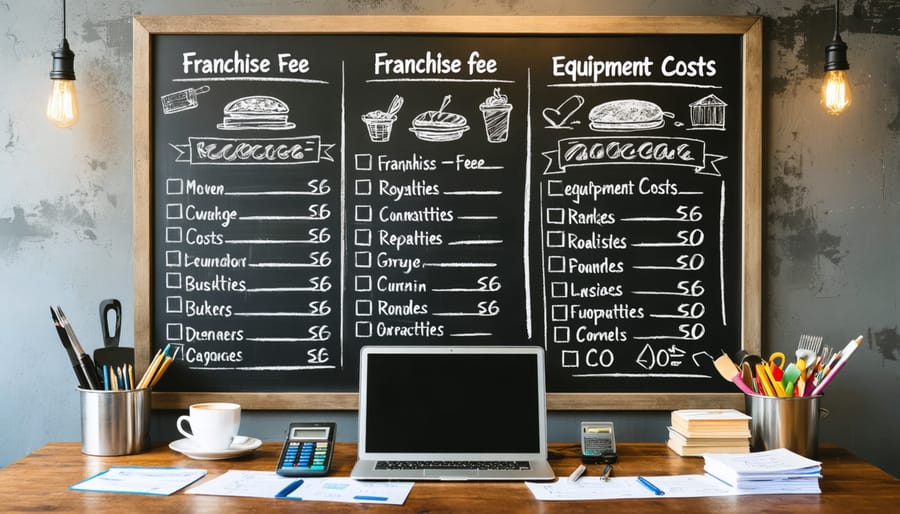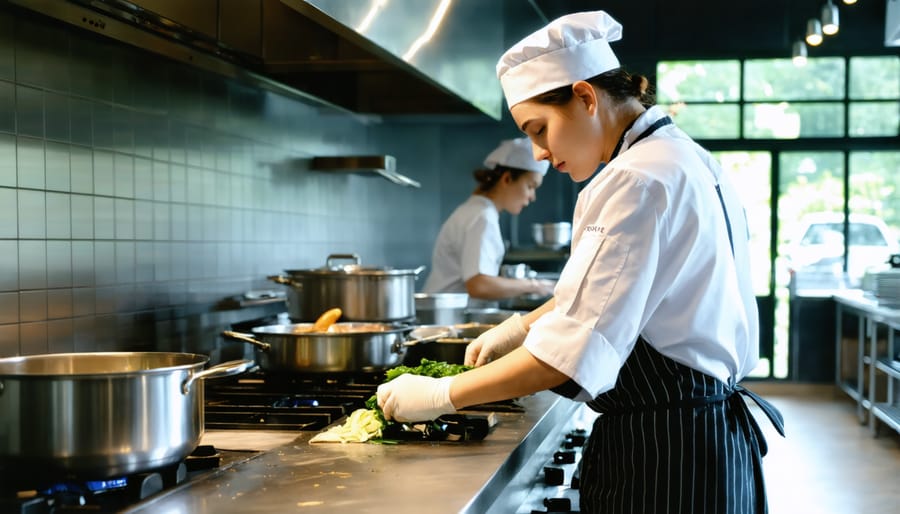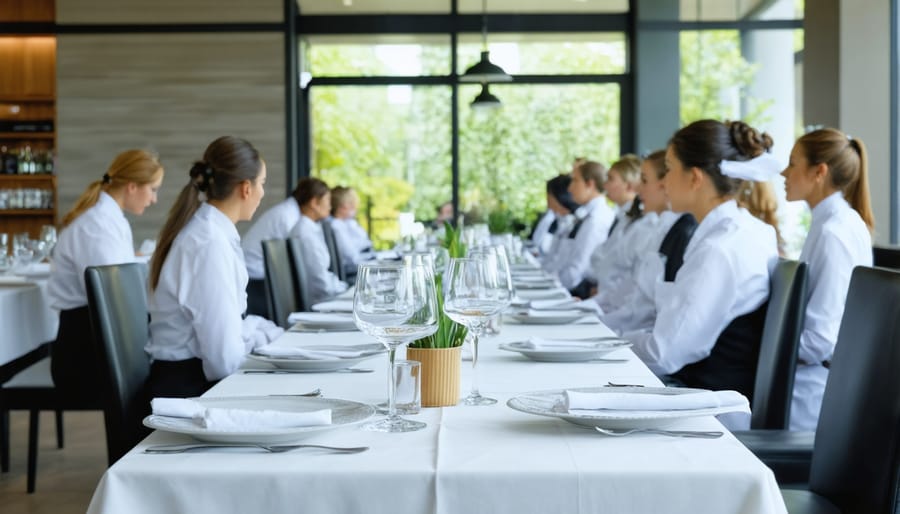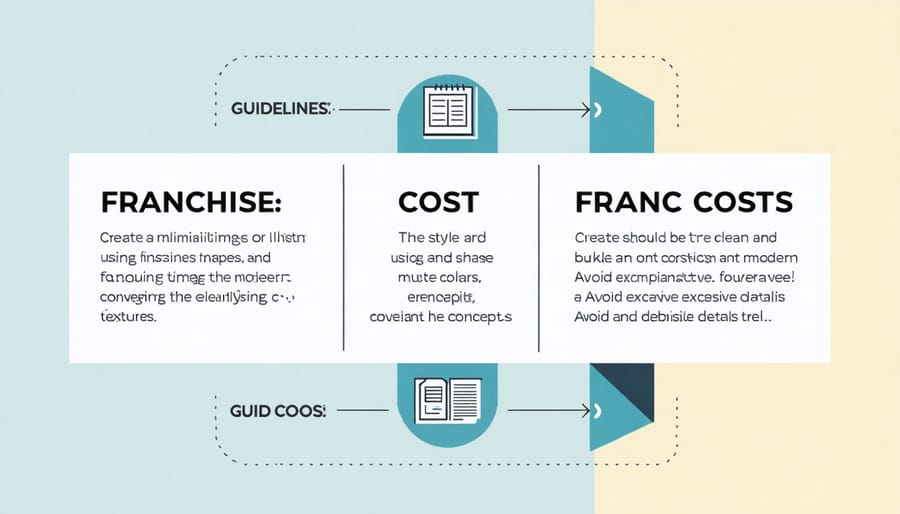
Starting a restaurant franchise requires substantial capital investment, typically ranging from $200,000 to $2 million – but understanding the true costs goes far beyond that initial figure. As someone who’s helped countless aspiring restaurateurs navigate these waters, I can tell you that success in restaurant franchising basics hinges on grasping both obvious and hidden expenses.
Beyond the franchise fee and build-out costs, prospective franchisees often overlook critical expenses like ongoing royalties (usually 4-8% of gross sales), marketing fees (2-4%), employee training programs, and inventory management systems. While popular chains like McDonald’s or Subway might offer instant brand recognition, they also command premium investment requirements and stricter operational standards.
What truly surprises many first-time franchisees isn’t just the upfront costs – it’s the working capital needed to sustain operations during the crucial first year. From payroll and insurance to unexpected equipment repairs and seasonal fluctuations in business, maintaining healthy cash flow requires careful planning and substantial financial reserves.
Whether you’re dreaming of opening a cozy coffee shop franchise or a full-service restaurant, understanding these costs isn’t just about numbers – it’s about preparing for a life-changing business venture that demands both financial and personal investment.
Initial Franchise Investment Breakdown
Franchise Fee and Territory Rights
Let’s talk about one of the biggest investments you’ll make when starting your franchise journey – the franchise fee and territory rights. Think of this as your “membership card” to join the franchise family, and trust me, it’s a crucial step in your successful franchise launch strategies.
The initial franchise fee typically ranges from $20,000 to $50,000 for most restaurant concepts, though premium brands might charge upwards of $100,000. This fee grants you the right to use the brand name, access their proven business system, and receive initial training and support. I remember chatting with Sarah, a local franchise owner, who shared that while the fee seemed daunting at first, the brand recognition and support system made it worthwhile.
Territory rights are equally important – they determine where you can operate your restaurant without competition from other franchisees of the same brand. Some franchisors offer protected territories based on population density or geographic boundaries, while others might grant exclusive rights to specific locations like shopping malls or downtown areas.
Before signing on the dotted line, carefully review the territory agreement. Consider factors like population growth, local competition, and development plans in your area. Remember, a well-chosen territory can make a significant difference in your restaurant’s success!
Equipment and Build-Out Costs
Let’s talk about one of the biggest investments you’ll make in your franchise restaurant journey – the equipment and build-out costs. Trust me, this is where having a detailed plan really pays off!
Your kitchen will need commercial-grade everything: ovens, refrigerators, food prep stations, and dishwashers. These aren’t your typical home appliances; we’re looking at anywhere from $100,000 to $300,000 just for kitchen equipment, depending on your franchise’s requirements and restaurant size.
Remember those beautiful dining rooms in your favorite franchise locations? Creating that ambiance isn’t cheap! The build-out costs typically include flooring, lighting, tables, chairs, booths, and décor elements. Many franchisors have specific requirements for these items to maintain brand consistency. You’re typically looking at $150,000 to $400,000 for the dining area alone.
Don’t forget about behind-the-scenes necessities like your POS system, security cameras, and fire suppression systems. These technical elements usually run between $20,000 to $50,000. And here’s something many first-time franchisees overlook: you’ll need a budget for backup equipment or repairs during those crucial first months.
A helpful tip from my experience working with successful franchisees: consider leasing some equipment initially to reduce your upfront costs. Many have found this strategy helpful in managing their initial investment while building their customer base.

Hidden Operating Expenses

Training and Staff Development
As a franchise owner, one of your most significant ongoing investments will be in your team. From my experience working with successful franchise operators, I’ve learned that implementing effective staff training programs is crucial for maintaining brand standards and delivering consistent customer experiences.
Initial training costs typically range from $5,000 to $15,000 per manager and $1,000 to $2,500 per staff member. This includes orientation, food safety certification, POS system training, and brand-specific protocols. Remember to factor in that you’ll likely need to train multiple staff members simultaneously during launch.
Beyond initial training, you’ll need to budget for ongoing development. This includes regular refresher courses, new menu item training, and leadership development programs. Many franchisors charge annual training fees of $1,500 to $3,000 per location to cover updated materials and continuing education.
I recently chatted with Sarah, a successful franchise owner in Toronto, who shared that she sets aside roughly 3% of her annual revenue for staff development. “It’s not just about teaching them how to make the food,” she explained. “It’s about creating a team that understands customer service, food safety, and our brand values.”
Don’t forget to account for indirect training costs like temporary coverage while staff attend training sessions, training materials, and potential travel expenses for mandatory franchisor workshops. While these expenses might seem steep initially, investing in your team’s development typically leads to lower turnover rates and higher customer satisfaction – both crucial for long-term success.
Marketing and Advertising Fees
Let’s talk about one of the most crucial ongoing expenses in running a franchise restaurant – marketing and advertising fees. Trust me, these aren’t just optional extras; they’re essential investments in your business’s success!
Most franchise agreements require you to contribute a percentage of your monthly sales (typically 2-4%) to a national marketing fund. I remember chatting with Sarah, a successful franchise owner, who explained how these contributions helped her business benefit from nationwide advertising campaigns she could never afford on her own.
But here’s something many aspiring franchise owners don’t realize: that’s just part of the marketing picture. You’ll also need to budget for local advertising efforts. Most franchisors require you to spend an additional 1-3% of your sales on marketing within your territory. This might include social media campaigns, local event sponsorships, and community engagement activities.
Let’s break down what you might expect to pay:
– National marketing fund: $2,000-4,000 monthly (based on $100,000 monthly sales)
– Local advertising: $1,000-3,000 monthly
– Grand opening marketing: $5,000-20,000 (one-time cost)
Pro tip: When reviewing franchise agreements, pay special attention to any marketing requirements. Some franchisors are more flexible than others about how you spend your local advertising dollars. Also, consider joining your franchise’s marketing committee – it’s a great way to have a voice in how those national marketing funds are used!
Remember, while these fees might seem substantial, they’re investing in your restaurant’s visibility and growth. The key is ensuring you’re making the most of every marketing dollar spent.

Ongoing Financial Commitments
Royalty Structure
Let’s talk about one of the most important ongoing costs in running a franchise restaurant – royalty fees. Think of these as your monthly “thank you” payments to the franchise brand for letting you use their name, recipes, and business system.
Most franchise restaurants charge royalties as a percentage of your gross sales, typically ranging from 4% to 8%. For example, if your restaurant brings in $50,000 in monthly sales and your royalty rate is 5%, you’ll need to set aside $2,500 for that month’s royalty payment. It’s like having a silent business partner who gets their share regardless of whether you’re profitable or not.
I recently chatted with Sarah, a successful franchise owner, who shared that while royalty fees initially felt like a burden, she came to appreciate the value they provide. “The ongoing support, national marketing campaigns, and updated training materials make it worth every penny,” she explained.
Besides the standard royalty fee, many franchises also require a marketing or advertising fee (usually 1-3% of sales) that goes into a collective fund for national promotions. Pro tip: When comparing different franchise opportunities, look beyond just the royalty percentage – consider what support services and resources you’re getting in return.
Remember, these fees are non-negotiable and continue throughout your franchise agreement, so factor them into your long-term business planning.
Supply Chain Costs
Let me share a little secret about franchise restaurants – the magic behind their consistent taste and quality lies in their supply chain management. As a frequent visitor to various franchise locations, I’ve noticed how every burger, salad, or sandwich tastes exactly the same, whether I’m in New York or California.
Your franchise agreement typically includes established relationships with approved suppliers, which can be both a blessing and a challenge for your bottom line. While these partnerships often guarantee bulk pricing discounts, they also mean you’re committed to purchasing specific ingredients, packaging, and supplies from designated vendors – even if you find better deals elsewhere.
The costs here go beyond just food ingredients. Think about those branded cups, napkins, takeout containers, and even cleaning supplies that maintain brand consistency. Most franchisors require regular inventory orders to maintain quality standards, which means you’ll need to factor in both storage space and the capital to maintain required stock levels.
Here’s a helpful tip: while you can’t choose your suppliers, you can optimize your ordering system. Many successful franchise owners I’ve spoken with use inventory management software to track usage patterns and reduce waste. This way, you’re not tying up too much capital in inventory while ensuring you never run out of essential items during peak hours.
Financial Planning Tips
Let’s talk about making your franchise dreams a reality with some practical money-management tips! Having guided several aspiring restaurant owners through their journeys, I’ve learned that smart financial planning for franchises can make all the difference between success and stress.
First, create a detailed emergency fund that covers at least six months of operating expenses. Trust me, this safety net will help you sleep better at night! Consider setting aside 10-15% of your projected monthly revenue for unexpected costs like equipment repairs or seasonal slowdowns.
Partner with a franchise-experienced accountant early in your journey. They’ll help you navigate tax implications and identify potential deductions specific to the restaurant industry. I remember when my friend Sarah saved thousands just by properly structuring her franchise’s initial expenses!
Look into different financing options beyond traditional bank loans. Many franchisors offer in-house financing programs, and you might qualify for Small Business Administration (SBA) loans with favorable terms. Consider creative solutions like equipment leasing to preserve your capital for other essential startup costs.
Implement a robust inventory management system from day one. This might seem basic, but I’ve seen too many new franchise owners struggle with food waste and overordering. Use technology to your advantage – modern POS systems can help track inventory and predict ordering needs based on sales patterns.
Don’t forget about insurance planning! Besides the obvious liability coverage, consider business interruption insurance and key person insurance. These might seem like extra expenses now, but they’re crucial for protecting your investment long-term.
Finally, establish clear financial benchmarks and review them monthly. Track your food costs, labor expenses, and profit margins against industry standards. This regular check-in helps you spot potential issues before they become problems and keeps you focused on your growth goals.
Remember, successful franchise ownership is a marathon, not a sprint. Take time to build strong financial foundations, and you’ll be better positioned for sustainable growth.
Investing in a restaurant franchise is undoubtedly a significant financial commitment, but it can also be an incredibly rewarding venture when approached with careful planning and realistic expectations. As we’ve explored throughout this article, the total investment typically ranges from $200,000 to well over $1 million, depending on the brand and location you choose.
Remember, beyond the initial franchise fee, you’ll need to account for ongoing costs like royalties, marketing fees, equipment maintenance, and staff training. It’s crucial to maintain a healthy emergency fund for unexpected expenses – something I learned firsthand from conversations with successful franchisees in our community.
While the costs might seem daunting at first, many franchise owners find that the built-in support system, established brand recognition, and proven business model make the investment worthwhile. The key is to choose a franchise that aligns with both your financial capabilities and personal goals.
Before taking the plunge, I encourage you to speak with multiple franchise owners, carefully review the Franchise Disclosure Document, and consult with financial advisors. Consider starting with a smaller concept if you’re new to the industry, or partner with experienced investors to share both the costs and risks.
Remember, success in franchising isn’t just about having enough capital – it’s about smart planning, dedication, and a genuine passion for the restaurant industry. Take your time to research, save, and prepare thoroughly before embarking on this exciting entrepreneurial journey.



